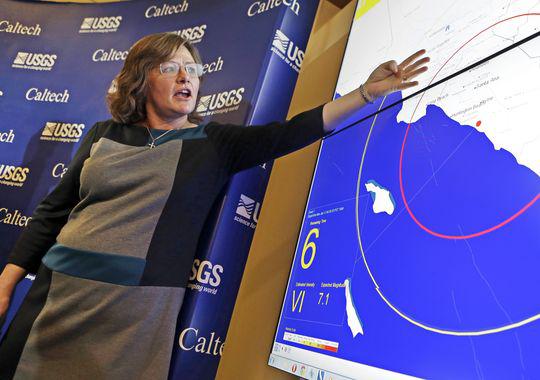
Scientists have come up with a new forecast estimating the chances of earthquakes in California, and they say the probability of a strong magnitude-8 quake has grown. Researchers said in a study released this week the estimated risk of a magnitude-8 or larger earthquake in the next 30 years has increased to 7%, up from 4.7% in the previous assessment in 2008. Meanwhile, they said they now expect moderate-sized earthquakes of magnitudes from 6.5 to 7.5 to be somewhat less frequent than they had previously forecast. Earthquakes of magnitude 6.7 or larger — the size of the 1994 Northridge quake — are projected to strike once every 6.3 years down from once every 4.8 years.
Ned Field, a USGS geophysicist and lead author of the study, said the new forecast was created using a model that incorporates the latest research and seismological data. “What the model really does provide is where and how often earthquakes will occur throughout the state,” Field said. The findings will help update building codes and earthquake insurance policies, and will affect how engineers design skyscrapers, hospitals, bridges and schools. “This will help all those people working to make society safe,” Field said. “It will help them do a better job of that.”
David Oglesby, a seismologist at UC Riverside who wasn’t involved in preparing the forecast, said the study will also contribute to emergency preparedness. "It allows us to focus our efforts in places that can do the most good.”
Scientists have long warned that the southern part of the San Andreas is overdue for a strong earthquake — in part because the last time a big quake hit the area was around 1690. "The southern San Andreas, going through the Coachella Valley and up through the Mojave, is the most likely place in the state to host a large earthquake," Field said. "Plate tectonic stresses have really built up beyond where they do on average. And so we think that those areas are particularly high in terms of the likelihood of having a large earthquake."
1.The scientists have concluded ______.
A earthquakes of magnitude 6.7 or larger will happen less.
B the probability of a strong earthquake has never changed
C the estimated risk of a magnitude-8 has increased by 2.3%.
D earthquakes of magnitudes from 6.5 to 7.5 will be more often.
解析:选C。C。细节理解题。根据第1段第2句的Researchers said in a study released this week the estimated risk of a magnitude-8 or larger earthquake in the next 30 years has increased to 7%, up from 4.7%可知八级以上的地震发生的可能性增加了2.3%。
2.With the help of the model, people can _____.
A tell how the earthquake happens
B predict the time of earthquake
C research the seismological data
D find the magnitude of earthquake
解析:选B。B。细节理解题。根据第2段What the model really does provide is where and how often earthquakes will occur throughout the state可以得知这个设备能够预测地震发生的地点和频率。
3.Who will benefit from the findings?
A Insurance companies.
B Automobile engineers.
C Information students.
D Professional singers.
解析:选A。A。细节理解题。根据第2段第3句的The findings will help update building codes and earthquake insurance policies可知是保险公司能从研究中受益。
4.What David Oglesby said in the third paragraph means ______.
A people have made society safe
B earthquakes will ruin the city
C people should focus on forecast
D the study helped keep people safe
解析:选D。D。推理判断题。根据第3段第2句的"It allows us to focus our efforts in places that can do the most good可知他说的意思为这项研究对保证人们安全有帮助。
5.Why is San Andreas more likely to have strong earthquake?
A Because plate tectonic stresses have accumulated.
B Because it’s a short time since the last earthquake.
C Because San Andreas is located in the high place.
D Because it goes through the Coachella Valley.
解析:选A。A。推理判断题。根据文章最后1段第3句的"Plate tectonic stresses have really built up beyond where they do on average可知是因为板块之间的压力的积聚才导致了地震的发生。